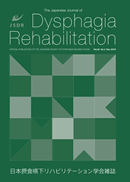Volume 19, Issue 1
The Japanese Journal of Dysphagia Rehabilitation
Displaying 1-11 of 11 articles from this issue
- |<
- <
- 1
- >
- >|
Original Paper
-
2015Volume 19Issue 1 Pages 3-10
Published: April 30, 2015
Released on J-STAGE: April 24, 2020
Download PDF (582K) -
The Relationship with Aspiration on Videoendoscopic Evaluation of Swallowing and Inflammation States2015Volume 19Issue 1 Pages 11-16
Published: April 30, 2015
Released on J-STAGE: April 24, 2020
Download PDF (315K) -
2015Volume 19Issue 1 Pages 17-23
Published: April 30, 2015
Released on J-STAGE: April 24, 2020
Download PDF (459K) -
2015Volume 19Issue 1 Pages 24-32
Published: April 30, 2015
Released on J-STAGE: April 24, 2020
Download PDF (660K) -
2015Volume 19Issue 1 Pages 33-40
Published: April 30, 2015
Released on J-STAGE: April 24, 2020
Download PDF (544K) -
2015Volume 19Issue 1 Pages 41-51
Published: April 30, 2015
Released on J-STAGE: April 24, 2020
Download PDF (679K) -
2015Volume 19Issue 1 Pages 52-62
Published: April 30, 2015
Released on J-STAGE: April 24, 2020
Download PDF (616K)
Short Communication
-
2015Volume 19Issue 1 Pages 63-68
Published: April 30, 2015
Released on J-STAGE: April 24, 2020
Download PDF (327K)
Case Report
-
2015Volume 19Issue 1 Pages 69-74
Published: April 30, 2015
Released on J-STAGE: April 24, 2020
Download PDF (856K) -
2015Volume 19Issue 1 Pages 75-81
Published: April 30, 2015
Released on J-STAGE: April 24, 2020
Download PDF (536K)
Clinical Hint
-
2015Volume 19Issue 1 Pages 83-88
Published: April 30, 2015
Released on J-STAGE: April 24, 2020
Download PDF (473K)
- |<
- <
- 1
- >
- >|
